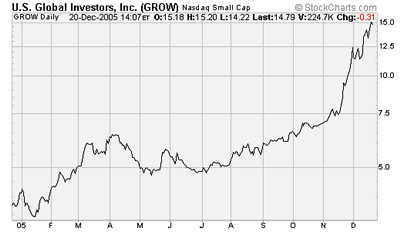| Home | About Us | Resources | Archive | Free Reports | Market Window |
Sorry, Ladies... The Truth About Diamond JewelryBy
Wednesday, December 21, 2005
When the ladies in my family heard about my interest in diamond mine investing, they asked: “Instead of buying a diamond stock, how about buying diamonds for us?” Not so fast, ladies... There’s a big difference between what’s under the counter at jewelry stores and how you make money in “real assets” like diamonds... You’ll make money in diamonds the same way you’ll make it in gold coins, stamps or any other type of collectible. In short, you have to own the best. You have to own what’s rare and desirable – the “beachfront property” as my friend and collectibles expert Van Simmons says. Why? Because “beachfront property” assets go up the most in bull markets, and give up the least in a downturn. Speculative real estate a mile from the beach can crash in value as speculators disappear. But beachfront property generally remains desirable. Also, the really expensive stuff is usually bought by people with a heck of a lot of money... they’re not buying on credit. They can afford to let it sit for a long time. I only recommend buying certified gold coins. The same is true of diamonds. Richard Russell talked about diamonds in his latest newsletter, out yesterday. He said: “Anyone buying a diamond with a certificate can know roughly what the diamond is worth. This has placed diamonds almost in the class of a commodity, and actually a form of money.” The diamonds at the jewelry store don’t qualify. What you’re buying at the jewelry store isn’t worth much...
There is one bright spot here, ladies, if you can swing it. Get your man involved. Get him to understand that you can’t buy any old diamond. If it is to be a store of value at all, you’ve got to get something exceptional, and certified. You’ve got to get beachfront property, with title. I expect we’re at the beginning of what could be a decade-long bull market in exceptional real assets. Rare gold coins and diamonds qualify. Diamond prices were near 20-year lows (adjusted for inflation) at the end of 2003. But they’ve risen about 30% since then. The bull market in real stuff – like collectibles – has just begun. For you to make the most money, you need to buy exceptional items only. So you don’t get taken, I highly recommend dealing with the most reputable dealers possible (I point my newsletter subscribers in the direction of a few dealers I consider reputable). When it comes time to sell, you can sell on eBay, and most likely get a higher price than a dealer would give you. You also get paid before you have to deliver the merchandise, so it’s not as risky. But I don’t recommend buying these expensive collectibles on eBay. At a party over the weekend, the host told me he paid $3,000 for an item on eBay. The seller took his money, and then disappeared without sending him what he bought. When you combine this with the risk of fraud, misrepresentation, and counterfeits, it’s just not worth it for these high value items. To sum up, buy right... buy beachfront. Buy rare, extraordinary items. Buy from as reputable a dealer as you can, instead of something like eBay. And to maximize what you get when it’s time to sell, consider selling on eBay. You’ll maximize your rewards in this bull market if you do these things. Good investing, Steve Market NotesMARKET NOTES The bull market in raw materials is showing up in hundreds of places… one of which is asset management. With its Global Resources Fund (PSPFX) receiving Lipper’s 2005 Best Natural Resources Fund Award, mutual fund manager U.S. Global Investors Inc. is seeing huge growth in assets and revenue. U.S. Global, which specializes in commodity investment, grew assets under management by 78% in the third quarter 2005. The stock price of U.S. Global (GROW) has grown as well. A one-year chart of GROW:
|
Recent Articles
|


